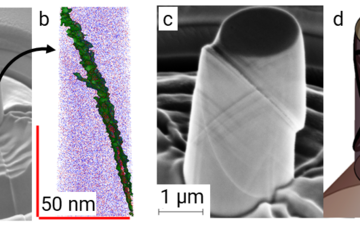All genres
861.
Journal Article
Slip system determination by rolling texture measurements around the strength peak temperature in a Fe3Al-based alloy. Materials Science and Engineering A 387–389, pp. 950 - 954 (2004)
862.
Journal Article
Texture Analysis of a Coarse Grained Fe3Al Cast Alloy by Neutron Scattering. Genf-Experimental Report 2003, pp. 183 - 199 (2004)
863.
Journal Article
Numerical study of textures and Lankford values for FCC polycrystals by use of a modified Taylor model. Computational Materials Science 29, 3, pp. 259 - 395 (2004)
864.
Journal Article
Overview on the Lattice Boltzmann Method for Nano- and Microscale Fluid Dynamics in Materials Science and Engineering. Modelling and Simulation in Materials Science and Engineering 12, pp. R13 - R46 (2004)
865.
Journal Article
Crystallographic texture, amorphization, and recrystallization in rolled and heat treated polyethylen terephtalate (PET). Polymer 45, pp. 8265 - 8277 (2004)
866.
Journal Article
Experimental study on the thermal stability of Cr filaments in a Cu–Cr–Ag in situ composite. Scripta Materialia 51, pp. 915 - 920 (2004)
867.
Journal Article
Using texture components in crystal plasticity finite element simulations. International Journal of Plasticity 20, pp. 339 - 361 (2004)
868.
Journal Article
Comparison of Single Crystal Simple Shear Deformation Experiments with Crystal Plasticity Finite Element Simulations. Advanced Engineering Materials 6, 8, pp. 653 - 656 (2004)
869.
Journal Article
Annealing effects on the microstructure and texture of a multifilamentary Cu–Nb composite wire. Scripta Materialia 51, pp. 1099 - 1104 (2004)
870.
Journal Article
Effects of Topology on Abnormal Grain Growth in Silicon Steel. Acta Materialia 51, pp. 1755 - 1765 (2003)
871.
Journal Article
Deformation Behaviour of Aluminium-Bicrystals. Advanced Engineering Materials 5, No.8, pp. 563 - 566 (2003)
872.
Journal Article
Mosaic Size Distributions in an Aluminum Bi-crystal Deformed by Channel Die Plane Strain Compression. Journal of Neutron Research 11 (4), pp. 209 - 214 (2003)
873.
Journal Article
Overview on basic types of hot rolling textures of steels. Steel Research 74, pp. 327 - 337 (2003)
874.
Journal Article
A New Finite Element Method for Predicting Anisotropy of Steels. Steel Research 74, pp. 181 - 182 (2003)
875.
Journal Article
Grain-scale micromechanics of polycrystal surfaces during plastic straining. Acta Materialia 51, pp. 1539 - 1560 (2003)
876.
Journal Article
High resolution EBSD investigation of deformed and partially recrystallized IF steel. Advanced Engineering Materials 5, No.8, pp. 566 - 570 (2003)
877.
Journal Article
On the influence of the grain boundary misorientation on the plastic deformation of aluminum bicrystals. Acta Materialia 51, pp. 4719 - 4735 (2003)
878.
Journal Article
Don’t trust your simulation - Computational materials science on its way to maturity? Advanced Engineering Materials 4 (5), pp. 255 - 267 (2002)
879.
Journal Article
Theory of orientation gradients in plastically strained crystals. Acta Materialia 50 (2), pp. 421 - 440 (2002)
880.
Journal Article
Abnormal grain growth in silicon steel. Proc. ICOTOM 13, pp. 949 - 954 (2002)











